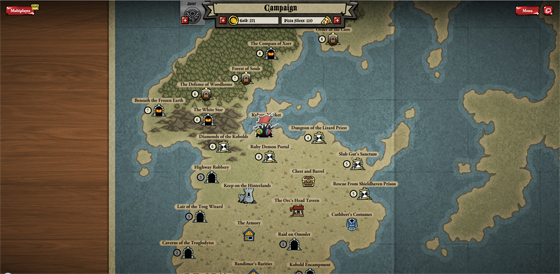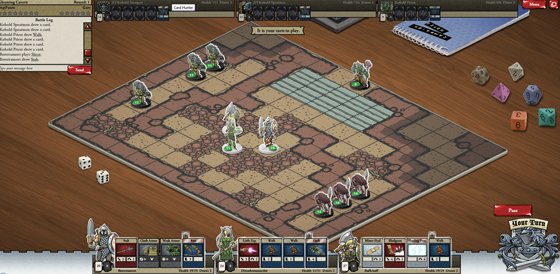You’ve probably never heard of Card Hunter (unless you’re reading this in the future and it’s become really successful). That’s understandable, it’s a turn based browser RPG, which is hardly a PR dream. The beauty of it doesn’t come across in the screenshots though, it’s in the ‘just one more dungeon’ compulsion which is present in the best turn based games. Which isn’t to say this is comparable to the likes of XCOM or Civilization, but that moreishness is still there.
The theme of Card Hunters is very tongue in cheek, lampooning the stereotype of the Dungeons and Dragons geek. Personally I can take the fluff or leave it – nerdy GMs besotted with the pizza girl, self righteous alpha-nerds leering at the younger players, frilly pseudo-medieval phrases. It’s all bollocks, but it’s not intrusive. It does, however, lend itself nicely to the graphics. Card pieces on a board surrounded the paraphernalia of roleplaying club meets make for a nice, clean interface with amusingly camp characters.
Enough about the pretty interface though. The game is, as mentioned earlier, a turn based RPG. When I say RPG I mean it in the videogame sense – there’s no dialogue other than the click-through GM spiel, you just get thrown into an arena with a bunch of things to kill. In this case RPG is shorthand for ‘levels and random loot drops’ rather than ‘Roleplaying.’ Doesn’t really matter though, the combat is entertaining enough to make the game. And what a funny old thing that combat is. Instead of action points or a similar analogue, your party members are given a hand of cards. Each card represents one of the wide range of actions they can make – moving, attacking, casting spells – as well as passive stuff like armour and effects.
The cards thing is off-putting to me normally. They always seem like an unnecessary abstract and remind me of cash treadmill TCGs. In the case of Card Hunter though, I like the way it works. You don’t choose your deck, instead your equipment is composed of a handful of cards and your deck is the sum of that equipment. It takes the micromanagement out, but retains the random nature of drawing your skills and abilities which add unpredictability to the tactics.
The biggest stumbling block to most people is going to be the price model. It’s another free-to-play game, with a subscription which lets you unlock the one special bit of loot after each adventure and opens up ‘treasure hunt’ missions which, again, offer better gear. On top of that there’s the increasingly common option to purchase chests with random loot, and of course different card characters to play. It’s not strictly necessary, everything bar the cosmetics is available for free, but it’s that thing that makes you feel like a second class citizen.
The game is enjoyable though, which is the bit we’re all interested in. It might suffer from longevity problems once the single player campaign is complete, but multiplayer may alleviate that, and I won’t be surprised to see additional dungeons released (paid for, presumably). At least, as a free-to-play game, you can go and check it out for yourself.


